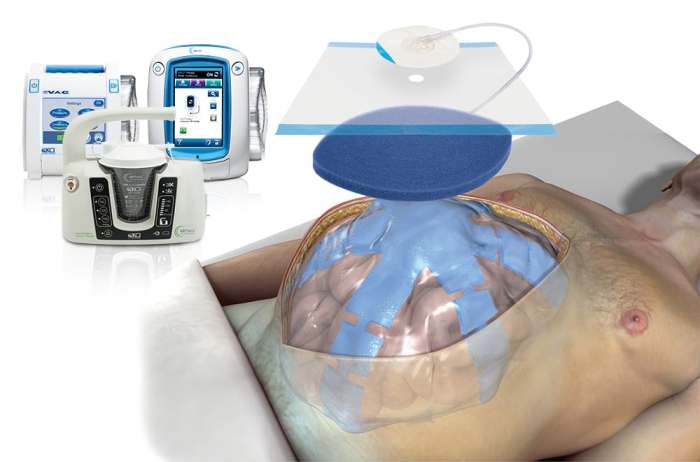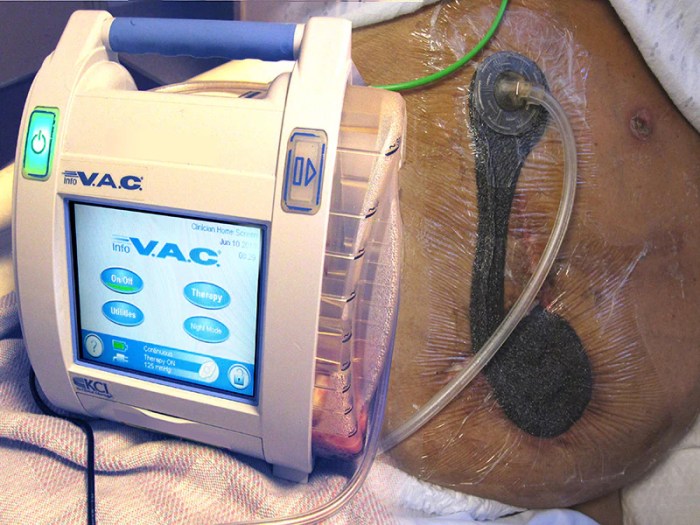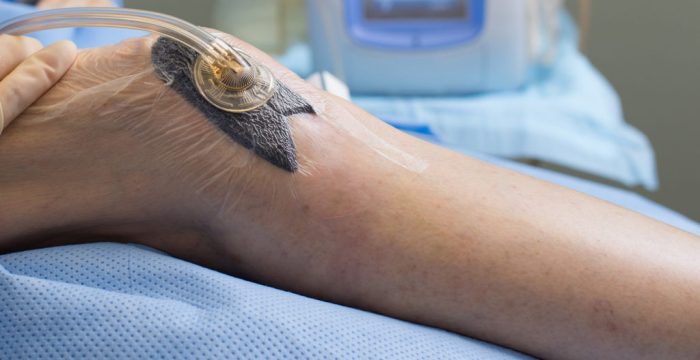Navigating the complexities of CPT for wound vac placement can be a daunting task. This comprehensive guide unravels the intricacies of the procedure, from its indications and benefits to the nuances of coding and billing. Dive into a world of wound care and emerge as a master of CPT for wound vac placement.
Our exploration begins with a deep dive into the definition and description of wound vac placement, laying the foundation for understanding the procedure’s purpose and indications. We’ll uncover the different types of wound vac systems available, empowering you with the knowledge to make informed decisions about patient care.
Definition and Description of Wound Vac Placement

Wound vac placement involves using a specialized device to create a controlled, negative pressure environment around a wound. This technique, also known as vacuum-assisted closure (VAC) therapy, promotes wound healing by removing excess fluid, stimulating blood flow, and reducing the risk of infection.
Indications for Wound Vac Placement
- Chronic wounds that have failed to heal with conventional treatment
- Large or complex wounds with significant tissue loss
- Wounds with excessive drainage or infection
- Wounds at risk of developing complications, such as pressure ulcers or diabetic foot ulcers
Types of Wound Vac Systems
There are various types of wound vac systems available, each with its unique design and features:
- Open-cell foam dressings:These dressings conform to the wound’s shape, providing a moist environment and absorbing excess fluid.
- Instillation dressings:These dressings deliver a saline solution to the wound, further promoting debridement and infection control.
- Negative pressure wound therapy (NPWT) devices:These devices create a continuous negative pressure around the wound, removing excess fluid and stimulating blood flow.
Benefits of Wound Vac Therapy
- Promotes wound healing by removing excess fluid and debris
- Reduces the risk of infection by creating a negative pressure environment
- Stimulates blood flow to the wound, promoting tissue growth
- Provides a moist wound environment, facilitating cell migration and proliferation
- Can be used on various types of wounds, including chronic, large, and complex wounds
Limitations of Wound Vac Therapy
- May be uncomfortable or painful for some patients
- Requires regular monitoring and dressing changes
- Can be expensive compared to other wound care methods
- May not be suitable for all types of wounds, such as those with exposed bone or tendon
- Can lead to skin irritation or damage if not used properly
CPT Code for Wound Vac Placement

Wound vac placement is a procedure that involves using a vacuum-assisted closure (VAC) device to promote wound healing. The specific CPT code for wound vac placement is 97605.
To use this code, the following criteria must be met:
- The wound must be a chronic wound that has not responded to other treatments.
- The wound must be located on the trunk or extremities.
- The wound must be large enough to accommodate the VAC device.
The following documentation is required to support the use of CPT code 97605:
- A description of the wound, including its size, location, and appearance.
- A description of the VAC device used.
- The duration of the VAC therapy.
Modifiers and Additional Codes
In some cases, modifiers or additional codes may be required to accurately describe the wound vac placement procedure. For example:
- Modifier 59 may be used to indicate that the wound vac placement was performed separately from another procedure.
- CPT code 97606 may be used to report the placement of a VAC device on the head or neck.
Procedure for Wound Vac Placement

Wound vac placement is a relatively simple procedure that can be performed in an outpatient setting. The steps involved are as follows:
Patient Preparation, Cpt for wound vac placement
The patient is first positioned comfortably on the treatment table. The wound is then cleansed with a sterile saline solution and the surrounding skin is shaved if necessary.
Wound Preparation
The wound is then debrided, which involves removing any dead or damaged tissue. This can be done using a variety of methods, such as scissors, curettes, or a scalpel.
CPT codes for wound vac placement can vary depending on the complexity of the wound and the specific type of device used. Just like the mythical King Midas, who turned everything he touched into gold, these codes can have a significant impact on reimbursement.
By understanding the nuances of wound vac placement coding, healthcare providers can ensure they are appropriately compensated for their services and avoid any financial pitfalls. King Midas in the Bible
Application of the Wound Vac System
Once the wound is prepared, the wound vac system is applied. The system consists of a suction pump, a collection canister, and a dressing that is placed over the wound. The suction pump creates a negative pressure environment within the dressing, which helps to draw out fluids and promote healing.
Special Considerations
There are a few special considerations that should be taken into account when placing a wound vac. These include:
- The size and location of the wound
- The amount of drainage
- The patient’s overall health
In some cases, it may be necessary to use a specialized dressing or to modify the suction settings to ensure that the wound vac is effective.
Post-Placement Care and Monitoring

After wound vac placement, proper care and monitoring are crucial to ensure optimal healing and prevent complications.Regular follow-up visits are necessary to assess the wound’s progress, monitor for signs of infection, and adjust the settings of the wound vac system.
The frequency of these visits will vary depending on the patient’s condition and the type of wound.
Dressing Changes and System Maintenance
Dressing changes are typically performed every 2-3 days, or as directed by the healthcare provider. The wound should be cleaned and inspected during each dressing change, and the suction tubing and canister should be checked for any leaks or blockages.The
wound vac system itself requires regular maintenance, including changing the batteries or power source, emptying the canister, and cleaning the tubing and attachments. The frequency of these tasks will vary depending on the specific system used.
Signs and Symptoms of Complications
It is important to be aware of the signs and symptoms of potential complications after wound vac placement, such as:
- Increased pain or discomfort around the wound
- Redness, swelling, or drainage from the wound
- Fever or chills
- A foul odor coming from the wound
- Skin breakdown or irritation around the wound
If any of these symptoms occur, it is important to contact the healthcare provider promptly for evaluation and treatment.
Reimbursement and Billing Considerations: Cpt For Wound Vac Placement
Wound vac placement is typically reimbursed under Medicare Part B, which covers medically necessary services provided by physicians and other healthcare professionals. Reimbursement rates vary depending on factors such as the location of the wound, the size of the wound, and the complexity of the procedure.Specific
documentation and coding requirements for billing wound vac placement include:
- Using the correct CPT code (97606 for initial placement, 97607 for subsequent placements)
- Providing a detailed description of the wound, including its size, location, and depth
- Documenting the medical necessity for wound vac placement
- Including any additional services performed, such as debridement or irrigation
- Submitting the claim with the appropriate modifiers, such as
- 59 (distinct procedural service) or
- 76 (repeat procedure by same physician)
FAQ Corner
What is the purpose of wound vac placement?
Wound vac placement aims to promote wound healing by creating a negative pressure environment that draws out fluids, reduces swelling, and stimulates tissue growth.
What are the different types of wound vac systems?
Wound vac systems vary in design and functionality. Common types include foam dressings, gauze dressings, and instillation systems.
How often should wound vac dressings be changed?
Dressing changes typically occur every 2-3 days, depending on the wound condition and the type of dressing used.